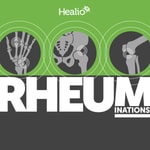Channel Your Enthusiasm – Détails, épisodes et analyse
Détails du podcast
Informations techniques et générales issues du flux RSS du podcast.

Channel Your Enthusiasm
Channel Your Enthusiasm
Fréquence : 1 épisode/64j. Total Éps: 26

A chapter by chapter recap of Burton Rose’s classic, The Clinical Physiology of Acid Base and Electrolyte Disorders, a kidney physiology book for nephrologists, fellows, residents and medical students.
Classements récents
Dernières positions dans les classements Apple Podcasts et Spotify.
Apple Podcasts
🇨🇦 Canada - medicine
22/06/2025#83🇨🇦 Canada - medicine
21/06/2025#57🇬🇧 Grande Bretagne - medicine
21/05/2025#87🇬🇧 Grande Bretagne - medicine
09/03/2025#95🇬🇧 Grande Bretagne - medicine
25/02/2025#73🇬🇧 Grande Bretagne - medicine
15/02/2025#84🇬🇧 Grande Bretagne - medicine
21/01/2025#71🇬🇧 Grande Bretagne - medicine
16/01/2025#71🇺🇸 États-Unis - medicine
16/01/2025#92🇬🇧 Grande Bretagne - medicine
15/01/2025#47
Spotify
Aucun classement récent disponible
Liens partagés entre épisodes et podcasts
Liens présents dans les descriptions d'épisodes et autres podcasts les utilisant également.
See allQualité et score du flux RSS
Évaluation technique de la qualité et de la structure du flux RSS.
See allScore global : 63%
Historique des publications
Répartition mensuelle des publications d'épisodes au fil des années.
Chapter Fifteen, part 2: Clinical Use of Diuretics
Saison 1 · Épisode 22
samedi 17 août 2024 • Durée 01:36:26
References
Proximal Tubule-Specific Deletion of the NHE3 (Na+/H+ Exchanger 3) in the Kidney Attenuates Ang II (Angiotensin II)-Induced Hypertension in Mice Melanie is in love with this paper that shows that sodium retention
Bumetanide and furosemide in heart failure everyone agreed that we love this classic paper from Craig Brater on diuretics (and the source of figure 15-6).
Lety referenced the Cr x 20 formula, a strategy to multiply the serum creatinine by 20 to estimate the initial furosemide dose. We agreed that this is more appropriate than the House of God formula of age + BUN = dose (which may be so much higher).
Joel shared this excellent report Diuretic Optimization Strategies Evaluation (DOSE) trial: https://www.nejm.org/doi/full/10.1056/nejmoa1005419
Amy shared how much she likes the two hour urine sodium (or random urine sodium) Rapid and Highly Accurate Prediction of Poor Loop Diuretic Natriuretic Response in Patients With Heart Failure - PMC
Anna shared this paper which suggests that urinary sodium is more closely linked to outcome compared to urine volume Natriuretic Response Is Highly Variable and Associated With 6-Month Survival: Insights From the ROSE-AHF Trial
and the study showing Substantial Discrepancy Between Fluid and Weight Loss During Acute Decompensated Heart Failure Treatment
Josh worried about obstructive sleep apnea and nocturia: Sleep disordered breathing and nocturnal polyuria: nocturia and enuresis.
WAITING FOR JOSH
JC mentioned this report from a group in the Netherlands regarding solute load and urine volume Determinants of Urine Volume in ADPKD Patients Using the Vasopressin V2 Receptor Antagonist Tolvaptan
We also considered CLICK trail Chlorthalidone for Hypertension in Advanced Chronic Kidney Disease | NEJM (and here’s the Freely Filtered Podcast on this topic- a really great episode! Freely Filtered 040: Double CLICK for BP control in CKD stage 4 — NephJC
Roger shared these articles on albumin and furosemide: Co-administration of albumin-furosemide in patients with the nephrotic syndrome and Albumin and Furosemide Combination for Management of Edema in Nephrotic Syndrome: A Review of Clinical Studies - PMC.
This is an interesting study that showed that the serum and urine albumin does not predict of the response to loop diuretics.Serum and Urine Albumin and Response to Loop Diuretics in Heart Failure | American Society of Nephrology
JC”s abstract on use of loop diuretics in hepatorenal syndrome type 1 was ultimately published in the American Journal of the Medical Sciences: https://doi.org/10.1016/S0002-9629(23)00623-7
Defining the role of albumin infusion in cirrhosis-associated hyponatremia this article explores the Gibbs-Donan Effect that Amy loves teaching us about.
Distal Convoluted Tubule | American Society of Nephrology Figure 1 is a favorite (and a prerequisite to friendship with melanie)
There is also a nice discussion of diuretic resistance in this year’s Nephmadness #NephMadness 2022: Cardiorenal Region – AJKD Blog
Josh is excited about starting an SGLT2 inhibitor for acute heart failure and Anna mentions this article about how they may prevent AKI: The SGLT2 Inhibitor Empagliflozin Might Be a New Approach for the Prevention of Acute Kidney Injury
Josh remembered this Tweetorial from Avi Cooper on the direct effect of furosemide: https://twitter.com/avrahamcoopermd/status/1292134482812604418?lang=en
Roger reminded us about the practice of using bedrest for heart failure: Prolonged Bed Rest in the Treatment of the Dilated Heart and rotating tourniquets Effectiveness of Congesting Cuffs ("Rotating Tourniquets") in Patients with Left Heart Failure | Circulation and Rotating Tourniquets for Acute Cardiogenic Pulmonary Edema | JAMA
Amy’s Voice of God: SGLT2i use in ADHF
CCJM: https://www.ccjm.org/content/91/1/47
EMPA AHF: https://pubmed.ncbi.nlm.nih.gov/38569758/
Joel’s Voice of God
The ADVOR Trial: https://www.nejm.org/doi/full/10.1056/NEJMoa2203094
NephJC coverage: http://www.nephjc.com/news/advor
Freely Filtered’s coverage: http://www.nephjc.com/freelyfiltered/52/advor
Outline Chapter 15 — Clinical Use of Diuretics
Part 2- beginning on page 460
- Determinants of Diuretic responsiveness
- 2 important determinants of diuretic response
- Site of action
- Presence of counterbalancing antinatriuretic forces
- Ang2
- Aldo
- Low systemic BP
- Adds rate of drug excretion as # 2 and a half
- Almost all diuretics are protein bound
- So not well filtered
- Enter tubule through organic anion and organic cation transporter
- This can limit diuretic effectiveness
- Natriuretic response plateaus at higher rates of diuretic excretion due to complete inhibition of the diuretic target
- This plateau in normal people is 1 mg of bumetanide and 40 mg of furosemide given IV
- Double this for oral furosemide, no adjustment needed for bumetanide
- 15-6
- Refractory edema
- Start with a loop diuretic
- Initial aim is to find the effective single dose
- From the paragraph this is about threshold dosing
- Double ineffective doses until good effect
- Suggests maximum furosemide dose is 200 mg IV and 400 mg oral
- Excess sodium intake
- High sodium diet can work to prevent patients from achieving negative sodium balance.
- Suggests diets after leaving the hospital maybe higher in sodium
- Decreased or delayed intestinal absorption
- Decreased intestinal perfusion, reduced intestinal motility and mucosal edema may contribute.
- But why is this worse with furosemide than with bumetidine or torsemide?
- Decreased drug entry into the tubular lumen
- Thiazides don’t work below a GFR of 20
- CLICK
- Renal failure
- Increased organic anions compete for diuretic secretion
- Bumetidine isn’t as dependent as furosemide on GFR
- Use 1/20th rather than 1/40th the dose
- Maximum of 8 to 10 mg
- Furosemide has ototoxicirty at high doses, he advises against 2400 mg/day
- There is a Na-K-2Cl carrier in the endolymph producing cells
- Ethacrynic acid has the most ototoxicity
- Only loop or thiazide that isn’t a sulfonamide derivative
- Cirrhosis
- Spiro is diuretic of choice
- More effective than loops alone
- Does not induce hypokalemia that can cause hepatic encephalopathy
- Cirrhosis causes marked hyperaldo
- Loop diuretics have to compete with bile salts for secretion in the proximal tubule
- Spiro does not need to be secreted in the proximal tubule
- Recommends to 100 to 40 spiro to furosemide ratio
- And can double this to 200 and 80/day
- and a maximum of of 400/160
- Hypoalbuminemia
- <2 g/dL associated with decreased diuretic entry into the lumen
- Protein binding keeps diuretics in the blood, reduces the volume of distribution
- This maximizes the delivery to the kidney
- In nephrotic syndrome tubular albumin can bind diuretic and prevent its activity
- Co administration of albumin with diuretic has resulted in modest improvements in diuretic effectiveness in various studies
- Intravenous infusion of loop diuretics
- Infusions are greater than bolus
- But if patient is not responding to blouses unlikely to respond to infusions since bolus provides a temporary spike in plasma level
- Increased distal reabsorption
- Increased distal sodium reabsorption decreases the effectiveness of proximal diuretics
- Due to aldo and increased sodium delivery
- Mentions that thiazides have a proximal effect (is that inhibition of carbonic anhydrase?)
- 15-8 is very cool
- Says all thiazides are created equal
- Article from 1972 is why people use metolazone in advanced renal disease
- When doing sequential nephron blocked be careful
- Loss of lots of fluid
- Loss of lots of potassium
- Loss of 5 liters and 200 mEq of K a day is possible with sequential nephron blockade
- Decreased loop sodium delivery
- With heart failure and cirrhosis increased proximal resorption mediated by Ang II markedly reduces delivery of fluid to the diuretic sensitive sites.
- Acetazolamide makes sense here
- Supine or 10 degree head down can increase cardiac output possibly increased venous return
- Can double Na excretion
- Increase CrCl 40%
- CAVH enters the chat!
- Other uses of diuretics
- Met alk, RTA, DI, hyponatremia due to SIADH, hypokalemia
- Diuretics and prostaglandins
- Loops and thiazides increase renal generation of prostaglandins
- Can cause venous dilation may help with acute pulmonary edema
- Can help without increased diuresis
- NSAIDS counter the effect of loop diuretics
- Is this natriuretic effect of PGE? Or due to renal ischemia due to unopposed Ang2 and norepi
- They also raise BP and reduce cardiac output due to increased vascular resistance
- Vasoconstrictor effect of loop diuretics
- One hour after loop diuretics increase vasoconstriction and rise in systemic blood pressure
- Increased Renin and norepinephrine, resolved 4 hours later
- Seen in heart failure and cirrhosis
- In cirrhosis decrease in RPF and GFR of 30-40% with furosemide
Chapter Fifteen, part 1: Clinical Use of Diuretics
Saison 1 · Épisode 21
lundi 13 mai 2024 • Durée 02:00:56
Outline Chapter 15 — Clinical Use of Diuretics
- Among most commonly used drugs
- Block NaCl reabsorption at different sites along the nephron
- The ability to induce negative balance has made them useful in multiple diseases
- Edematous states
- Hypertension
- Mechanism of action
- Three major classes
- Loop
- NaK2Cl
- Up to 25% of filtered sodium excreted
- Thiazide
- NCC
- Up to 3-5% of filtered sodium excreted
- Potassium sparing
- ENaC
- Up to 1-2% of filtered sodium excreted
- Each segment has a unique sodium channel to allow tubular sodium to flow down a concentration gradient into the cell
- Table 15-1 is interesting
- Most of the sodium 55-655 is reabsorbed in the proximal tubule
- Proximal diuretics would be highly effective if it wasn’t for the loop and other distal sites of Na absorption
- Loop Diuretics
- Furosemide
- Bumetanide
- Torsemide
- Ethacrynic acid
- NaK2Cl activated when all four sites are occupied
- Loop diuretic fits into the chloride slot
- In addition to blocking Na reabsorption results in parallel decrease in calcium resorption
- Increase in stones and nephro albinos is especially premature infants which can increase calcium excretion 10-fold
- Thiazide
- Even though they are less potent than loops they are great for hypertension
- “Not a problem in uncomplicated hypertension where marked fluid loss is neither necessary nor desirable”
- Some chlorothiazide and metolazone also inhibit carbonic anhydrase in the proximal tubule
- Increase Calcium absorption. Mentions that potassium sparing diuretics do this also
- Potassium sparing diuretics
- Amiloride
- Spironolactone
- Triamterene
- Act at principal cells in the cortical collecting tubule,
- Block aldosterone sensitive Na channels.
- Discusses the difference between amiloride and triamterene and spiro
- Mentions that trimethoprim can have a similar effect
- Spiro is surprisingly effective in cirrhosis and ascites
- Talks about amiloride helping in lithium toxicity
- Partially reverse and prevent NDI from lithium
- Trial Terence as nephrotoxin?
- Causes crystaluria and casts
- These crystals are pH independent
- Faintly radio opaque
- Acetazolamide
- Blocks carbonic anhydrase
- Causes both NaCl and NaHCO3 loss
- Modest diuresis de to distal sodium reclamation
- Mannitol
- Nonreabsorbable polysaccharide
- Acts mostly in proximal tubule and Loop of Henle
- Causes water diuresis
- Was used to prevent ATN
- Can cause hyperosmolality directly and through the increased water loss
- This hyperosmolality will be associated with osmotic movement of water from cells resulting in hyponatremia, like in hyperglycemia.
- Docs must treat the hyperosmolality not the hyponatremia
- Time course of Diuresis
- Efficacy of a diuretic related to
- Site of action
- Dietary sodium action
- 15-1 shows patient with good short diuretic response but other times of low urine Na resulting in no 24 hour net sodium excretion.
- Low sodium diets work with diuretics to minimize degree of sodium retension while diuretic not working
- Also minimizes potassium losses
- Increase frequency
- Increase dose
- What causes compensatory anti-diuresis
- Activation of RAAS and SNS
- ANG II, aldo, norepi all promote Na reabsorption
- But even when prazosin to block alpha sympathetic and capto[pril to block RAAS sodium retention occurs
- Decrease in BP retains sodium with reverse pressure natriuresis
- Even with effective diuresis there is reestablishment of a new steady state
- Diuresis is countered by
- Increases in tubular reabsorption at non-diuretic sensitive sites (neurohormonal mediated)
- Flow mediated in creases in Tubular reabsorption distal to the diuretic from increased sodium delivery.
- Hypertrophy
- Increased Na-K-ATPase activity
- Decreased tubular secretion of diuretic if renal perfusion is impaired
- Getting to steady state requires
- Diuretic dose and sodium intake be constant
- Sodium balance is reestablished with 3 days of a fixed diuretic dose
- K balance in 6-9 days
- Figure 15-2
- Which means that people on stable doses of diuretics don’t need regular labs, the abnormalities will emerge quickly.
- Maximum diuresis happens with first dose
- Figure 15-3
- Fluid and Electrolyte complications
- Volume depletion
- “Effective circulating volume depletion also can develop in patients who remain edematous. Although fluid persists, there may be a sufficient reduction in intracranial filling pressures and cardiac output to produce a clinically important reduction in tissue perfusion.”
- Azotemia
- Decreased effective circulating volume with diuretic therapy also can diminish renal perfusion and secondarily the GFR.
- Describes the traditional reason for increased BUN:Cr ratio
- Then states that as much as a third of of the rise in BUN may reflect increased urea production; it is possible, for example, that reduced skeletal muscle perfusion leads to enhanced local proteolysis. This increases urea production.
- Hypokalemia
- Loop and thiazide increase urinary potassium losses
- Often lead to hypokalemia
- 50 mg of HCTZ drop K by 0.4 to 0.6 mEq/L with 15% falling below 3.5
- He uses “associated” I think this is a place where we can use cause
- 50 mg of chlorthalidone
- K falls 0.8 to 0.9 mEq/L
- Etiology
- Increased distal delivery of Na and water
- Increased aldo
- From volume depletion
- Underlying disease: cirrhosis and heart failure
- Talk a lot about significance.
- Info sounds dated
- Increased risk of SCD in MRFIT trial
- Association with increased ventricular arrhythmia with hypokalmia
- Increased PVC and complex PVC by 27% with each drop in K of 0.5 mEq/L
- Says that stress can induce epinephrine which can shift potassium inside cells leading to fatal arrhythmia especially if the patient begins at a low potassium concentration
- Says v-fib two fold likely in MI patients with hypokalemia
- Talks about crazy doses of HCTZ and Chlorthalidone 50+mg
- Recommends 12.5 to 15 mg respectively
- Metabolic alkalosis
- Caused by loop and thiazide diuretics
- Two factors cause this
- Increased urinary H loss
- Partly UE to secondary hyperaldo
- Contraction of extracellular volume around remaining bicarb
- Why not contraction hypernatremia, contraction hyperkalemia, etc?
- Aldosterone contributes by stimulate ing H-ATPase
- Stimulating Sodium reabsorption creating lumen negative charge that promotes Hydrogen secretion
- Loop diuretics can also stimulate net H loss by increased Hsecretion in the cortical aspect of the thick limb
- This segment has two luminal entry points for na, the traditional NaK2Cl and Na-H exchanger
- Blocking NaK2Cl with loop diuretic stimulates the Na-H exchanger
- Can use NaCl or acetazolamide to treat
- Metabolic acidosis
- K-sparing diuretics reduce both K and H secretion in the collecting tubule
- Avoid if renal failure or on an ACEi
- Good advice to avoid K supplement with the K sparing diuretic
- Hyponatremia
- Diuretics can cause volume depletion leading to enhanced secretion of ADH and to increased water intake
- Almost always due to a thiazide
- Loops destroy the concentrated medullary gradient making ADH less effective
- Hyperdrive is
- Increased urate reabsorption in the proximal tubule
- Process mediated by parallel Na-H and urate OH exchangers see figure 3-13a
- Urate reabsorption varies directly with proximal Na transport and in patients with diuretic-induced volume deficiency both Na and urate excretion are reduced.
- May be related to Ang II
- Do not need to treat the hyperuricemia in asymptomatic patients
- Do not develop urate nephropathy because tubular urateis actually low
- Hypomagnesemia
- Generally mild
- Loop diuretics since most reabsorbed in the loop
- Thiazides don’t affect Mg (why with gitelmans?)
- Hypokalemia may directly inhibit tubular cell mg uptake
- Aldosterone increases Mg excretion, so K sparing diuretics decrease Mg secretion
- Determinants of Diuretic responsiveness
- 2 important determinants of diuretic response
- Site of action
- Presence of counterbalancing antinatriuretic forces
- Ang2
- Aldo
- Low systemic BP
- Adds rate of drug excretion as # 2 and a half
- Almost all diuretics are protein bound
- So not well filtered
- Enter tubule through organic anion and organic cation transporter
- This can limit diuretic effectiveness
- Natriuretic response plateaus at higher rates of diuretic excretion due to complete inhibition of the diuretic target
- This plateau in normal people is 1 mg of bumetanide and 40 mg of furosemide given IV
- Double this for oral furosemide, no adjustment needed for bumetanide
- 15-6
- Refractory edema
- Start with a loop diuretic
- Initial aim is to find the effective single dose
- From the paragraph this is about threshold dosing
- Double ineffective doses until good effect
- Suggests maximum furosemide dose is 200 mg IV and 400 mg oral
- Excess sodium intake
- High sodium diet can work to prevent patients from achieving negative sodium balance.
- Suggests diets after leaving the hospital maybe higher in sodium
- Decreased or delayed intestinal absorption
- Decreased intestinal perfusion, reduced intestinal motility and mucosal edema may contribute.
- But why is this worse with furosemide than with bumetidine or torsemide?
- Decreased drug entry into the tubular lumen
- Thiazides don’t work below a GFR of 20
- CLICK
- Renal failure
- Increased organic anions compete for diuretic secretion
- Bumetidine isn’t as dependent as furosemide on GFR
- Use 1/20th rather than 1/40th the dose
- Maximum of 8 to 10 mg
- Furosemide has ototoxicirty at high doses, he advises against 2400 mg/day
- There is a Na-K-2Cl carrier in the endolymph producing cells
- Ethacrynic acid has the most ototoxicity
- Only loop or thiazide that isn’t a sulfonamide derivative
- Cirrhosis
- Spiro is diuretic of choice
- More effective than loops alone
- Does not induce hypokalemia that can cause hepatic encephalopathy
- Cirrhosis causes marked hyperaldo
- Loop diuretics have to compete with bile salts for secretion in the proximal tubule
- Spiro does not need to be secreted in the proximal tubule
- Recommends to 100 to 40 spiro to furosemide ratio
- And can double this to 200 and 80/day
- and a maximum of of 400/160
- Hypoalbuminemia
- <2 g/dL associated with decreased diuretic entry into the lumen
- Protein binding keeps diuretics in the blood, reduces the volume of distribution
- This maximizes the delivery to the kidney
- In nephrotic syndrome tubular albumin can bind diuretic and prevent its activity
- Co administration of albumin with diuretic has resulted in modest improvements in diuretic effectiveness in various studies
- Intravenous infusion of loop diuretics
- Infusions are greater than bolus
- But if patient is not responding to blouses unlikely to respond to infusions since bolus provides a temporary spike in plasma level
- Increased distal reabsorption
- Increased distal sodium reabsorption decreases the effectiveness of proximal diuretics
- Due to aldo and increased sodium delivery
- Mentions that thiazides have a proximal effect (is that inhibition of carbonic anhydrase?)
- 15-8 is very cool
- Says all thiazides are created equal
- Article from 1972 is why people use metolazone in advanced renal disease
- When doing sequential nephron blocked be careful
- Loss of lots of fluid
- Loss of lots of potassium
- Loss of 5 liters and 200 mEq of K a day is possible with sequential nephron blockade
- Decreased loop sodium delivery
- With heart failure and cirrhosis increased proximal resorption mediated by Ang II markedly reduces delivery of fluid to the diuretic sensitive sites.
- Acetazolamide makes sense here
- Supine or 10 degree head down can increase cardiac output possibly increased venous return
- Can double Na excretion
- Increase CrCl 40%
- CAVH enters the chat!
- Other uses of diuretics
- Met alk, RTA, DI, hyponatremia due to SIADH, hypokalemia
- Diuretics and prostaglandins
- Loops and thiazides increase renal generation of prostaglandins
- Can cause venous dilation may help with acute pulmonary edema
- Can help without increased diuresis
- NSAIDS counter the effect of loop diuretics
- Is this natriuretic effect of PGE? Or due to renal ischemia due to unopposed Ang2 and norepi
- They also raise BP and reduce cardiac output due to increased vascular resistance
- Vasoconstrictor effect of loop diuretics
- One hour after loop diuretics increase vasoconstriction and rise in systemic blood pressure
- Increased Renin and norepinephrine, resolved 4 hours later
- Seen in heart failure and cirrhosis
- In cirrhosis decrease in RPF and GFR of 30-40% with furosemide
References
Melanie noted that thiazide diuretics were the Project MUSE - Releasing the Flood Waters: Diuril and the Reshaping of Hypertension
Furosemide early review of furosemide effect in a range of different clinical conditions.
Na+, K+, and BP homeostasis in man during furosemide: Effects of prazosin and captopril This article is quoted in Rose’s book-(Figure 2 is 5-1). The authors provide a figure with a balance study that shows how an initial “diuresis” is followed
https://jasn.asnjournals.org/content/30/2/216
Thiazide induced hyponatremia, a detailed phenotypic and genotypic analysis (NephJC) https://www.sciencedirect.com/science/article/pii/B9780126356908500025
Classic paper on diuretics in NEJM from Craig Brater: https://www.nejm.org/doi/full/10.1056/NEJM199808063390607
Diagnosis and management of Bartter syndrome: executive summary of the consensus and recommendations from the European Rare Kidney Disease Reference Network Working Group for Tubular Disorders https://linkinghub.elsevier.com/retrieve/pii/S0085253820314046
Nephrocalcinosis of 17% in preemies: https://pubmed.ncbi.nlm.nih.gov/35348900/
Nephrocalcinosis with loop diuretics in neonates: https://pubmed.ncbi.nlm.nih.gov/38296790/ and https://www.ncbi.nlm.nih.gov/pmc/articles/PMC6941622/
We wondered whether the effect of hypercalemia on loop is complete –did we go too far saying that loop diuretics have no effect
Anna’s VOG on hypercalciuria and lasix, etc. NEJM Paper describing the dose of lasix needed for calciuria Meta analysis of lasix used for calciuric effects . David Ellison and Robert Schrier experiment showing NCC activation with chronic loops. NCC activation occurs with hypercalcemia as well via CASR
Uromodulin upregulates TRPV5 by impairing caveolin-mediated endocytosis - University of Iowa
Regulation of Potassium Homeostasis | American Society of Nephrology Biff Palmer’s review.
Distal Convoluted Tubule - PMC we did not discuss this paper by Subramanya and Ellison but it is a gem
It Is Chloride Depletion Alkalosis, Not Contraction Alkalosis | American Society of Nephrology
Thiazide Effects and Adverse Effects | Hypertension
SGLT2i case series for hypomag: SGLT2 Inhibitors for Treatment of Refractory Hypomagnesemia: A Case Report of 3 Patients - PMC
Anti-EGFR monoclonal antibody-induced hypomagnesaemia - The Lancet Oncology
Chapter Nine: Regulation of Plasma Osmolality
Saison 1 · Épisode 11
lundi 31 octobre 2022 • Durée 01:40:11
References for Chapter 9
One of the few papers that Rose wrote as a single author explores electrolyte free water clearance. This seminal paper explores the issue in greater detail than the book. A New approach to disturbances in the plasma sodium concentration
Wondering about the volume of sweat? Josh taught us that the volume of “transepidermal volume loss” is not affected by humidity https://www.jidonline.org/article/S0022-202X(15)48145-X/pdf but is greatly affected by temperature: Skin temperature and transepidermal water loss
Regarding normal sweat physiology, there is a nice review (with figures!) titled Physiological mechanisms determining sweat composition which describes all the important cells and channels which make up sweat glands. And an important follow on paper titled Higher Bioelectric Potentials due to Decreased Chloride Absorption in the Sweat Glands of Patients with Cystic Fibrosis describing specifically the sweat characteristics of patients with cystic fibrosis.
Melanie was enchanted by work from RA McCance who did early experiments to induce sodium deficiency using very low sodium diets and a homemade sauna-like tent. His musings are fascinating. Lancet 1936 Experimental human salt deficiency MEDICAL PROBLEMS IN MINERAL METABOLISM
Age-related decline in urine concentration may not be universal: Comparative study from the US and two small-scale societies from Jeff Sands (of urea transport fame!)
In this initial report, after continually water loading 21 volunteers, the younger group (mean age 31) had a urine osmolality of 52 mOsm/kg compared to in the older group (mean age 84). Influence of age, renal disease, hypertension, diuretics, and calcium on the antidiuretic responses to suboptimal infusions of vasopressin. In a later report older subjects (mean age 72) vs younger controls (mean age 26) drank 20 ml/kg over 40 minutes. The younger group excreted more of the water in the first 2 hours and had a lower mean urine osmolality 86 vs 112 mOsm/kg compared to the older participants. Age-associated Alterations in Thirst and Arginine Vasopressin in Response to a Water or Sodium Load
Howard Furst suggests the urine to plasma electrolyte ratio as a simpler strategy to consider the free water clearance: https://nephrology.edublogs.org/files/2014/03/Water-Restriction-in-Hyponatremia1-1eb8n40.pdf or via pubmed: The urine/plasma electrolyte ratio: a predictive guide to water restriction
Chapter Eight: Regulation of The Effective Circulating Volume
Saison 1 · Épisode 10
vendredi 26 août 2022 • Durée 01:41:01
References for chapter 8
Robert Schrier proposed a unifying hypothesis to explain the sodium retention seen in edematous states like cirrhosis and heart failure, coining the term effective arterial blood volume (EABV). An open access review in JASN 2007 can be found here: https://jasn.asnjournals.org/content/18/7/2028#ref-3
John P Peters
ASN Annual Award: https://www.asn-online.org/about/awards/award.aspx?awh_key=0ea83199-f86d-4506-9507-d7e4ce688cb4
Short article discussing contributions of Dr. Peters by mentees Dr. Franklin Epstein and Dr. Donald Seldin: https://www.ncbi.nlm.nih.gov/pmc/articles/PMC2588700/ and https://pubmed.ncbi.nlm.nih.gov/12097739/
Epstein FH et al. Studies of the antidiuresis of quiet standing: the importance of changes in plasma volume and glomerular filtration. JCI 1950. In this classic report, investigators studied their own sodium excretion supine, standing and with a variety of maneuvers (saline or albumin infusion) and showed that urinary sodium excretion is limited in the upright position compared to supine position. https://www.ncbi.nlm.nih.gov/pmc/articles/PMC436228/pdf/jcinvest00414-0077.pdf
An interesting review of early concepts on hypertension feature notes on John J Hay and Paul Dudley White. The former was known to say, “The greatest danger to a man with high blood pressure lies in its discovery because then some fool is certain to try and reduce it!” and the latter has been quoted as saying that hypertension might be compensatory but apparently, these quotes are out of context. To find out what they really said, check out: Elias MF and Goodell AL. Setting the record straight for two heroes in hypertension John J Hay and Paul Dudley White. J Clin Hypertens 2019 https://onlinelibrary.wiley.com/doi/epdf/10.1111/jch.13650
VA Cooperative Trial was an important study to establish the hypertension should, in fact, be treated The VA Cooperative Study and the Beginning of Routine Hypertension Screening, 1964-1980
This study was stopped after only 18 months because of an excess of deaths in the untreated group who had a mean diastolic BP of 115 mmHg.
For a long time, only the diastolic BP was felt to be important until the Systolic Hypertension in Elderly Patients (“SHEP study”) clarified that treatment of isolated systolic hypertension is also important
Prevention of Stroke by Antihypertensive Drug Treatment in Older Persons With Isolated Systolic Hypertension
We continued to try to grapple with the work of Jens Titze on sodium which turns many of our assumptions about sodium upside down. His team studied astronauts on a long term high sodium diet and found an unexpected weekly (circaseptan) rhythm seemingly related inversely to aldosterone and directly with cortisol. His work also probes our notion of body sodium content. For a great first hand read, check out Dr TItze’s review in Kidney International 2014 which he aptly dubs, “Spooky Sodium Balence.” https://www.sciencedirect.com/science/article/pii/S0085253815562807
Epstein M. The cardiovascular and renal effects of head-out of water Immersion in Man. Circulation Research 1976 Cardiovascular and renal effects of head-out water immersion in man: application of the model in the assessment of volume homeos
Space flight is an exaggeration of the water immersion experiments. Astronauts on either a low or normal sodium diet had a reset of natriuetic peptides. A Salty Tale: Study Examines Sodium Regulation in Space and Natriuretic Peptide Resetting in Astronauts | Circulation
Baroreceptors feature mechanically activated ion channels called PIEZO1 and PIEZO2. Zeng W, Marshall KL, Min S, Daou I, Chapleau MW, Abboud FM. PIEZOs mediate neuronal sensing of blood pressure and the baroreceptor reflex. Science 2018 https://www.ncbi.nlm.nih.gov/pmc/articles/PMC5102061/
We also relearned an unfortunate truth: lots of folks pee in pools. De Laat et al. Water Res. 2011. Concentration levels of urea in swimming pool water and reactivity of chlorine with urea
At the American College of Cardiology meeting in April, investigators shared the news that the combination of an ARB with new class of drugs called angiotensin receptor neprilysin inhibitor (ARNI) was not superior to ACE inhibitors at reduction of heart failure following acute MI. Here’s the press release for the PARADISE-MI trial. Prospective ARNI vs. ACE inhibitor trial to DetermIne Superiority in reducing heart failure Events after Myocardial Infarction
A series of elegant experiments by Alicia McDonald’s team to characterize pressure natriuresis. In these studies, they induce hypertension by constriction of the superior mesenteric artery, the celiac artery and the infrarenal aorta (essentially increasing afterload without directly altering the blood flow to the kidney). With this maneuver, the blood pressure of the experimental animal rises, urinary sodium excretion increases and then they demonstrate a shift in the Na-H ATPase from the apical membrane to intracellular vesicles in the proximal tubule and a shift in NCC from the luminal membrane to the intracellular vesicles in the distal tubules.
Yang L et. al Acute hypertension provokes internalization of proximal tubule NHE3 without inhibition of transport activity. Am J Physiol Renal 2002 https://journals.physiology.org/doi/full/10.1152/ajprenal.00298.2001?rfr_dat=cr_pub++0pubmed&url_ver=Z39.88-2003&rfr_id=ori%3Arid%3Acrossref.org
Lee DH Riquier ADM, Yang LE, Leong PK, Maunsbach and McDonough AA. Acute hypertension provokes acute trafficking of distal tubule NaCl (NCC) to subapical cytoplasmic vesicles. Am J Physiol Renal Physiol. 2009 Acute hypertension provokes acute trafficking of distal tubule Na-Cl cotransporter (NCC) to subapical cytoplasmic vesicles This review in KI reports is also worth a read McDonough AA. Maintaining Balance under pressure-hypertension and the proximal tubule. 2015 ISN Forefronts Symposium 2015: Maintaining Balance Under Pressure—Hypertension and the Proximal Tubule
Chapter Seven: The Total Body Water and The Plasma Sodium Concentration
Saison 1 · Épisode 9
dimanche 24 avril 2022 • Durée 01:18:32
Chapter 7
References
Sands JM, Blount MA and Klein JD. Regulation of Renal Urea Transport by Vasopressin. https://www.ncbi.nlm.nih.gov/pmc/articles/PMC3116377/
In this invited piece, Sands and colleagues explain that although urea is permeable across membranes, this is slow, thus urea transporters in the kidney, under control of vasopressin, are needed to facilitate transport and create the medullary gradient.
Text book using 20% of extracellular compartment being in the intravascular compartment. https://courses.lumenlearning.com/ap2/chapter/body-fluids-and-fluid-compartments-no-content/
The chapter I wrote where I went through the math in figure 7-3. It was a major revelation to me: https://docs.google.com/document/d/17BM1xihvlztuQlU8GVNhEDoPLzr6GounHYZAtVUkLvw/edit?usp=sharing
Association Between ICU-Acquired Hypernatremia and In-Hospital Mortality https://journals.lww.com/ccejournal/fulltext/2020/12000/association_between_icu_acquired_hypernatremia_and.26.aspx
Rate of Correction of Hypernatremia and Health Outcomes in Critically Ill Patients https://pubmed.ncbi.nlm.nih.gov/30948456/
Edelman IS, Leibman J, O’Meara MP and Birkenfeld LW. Interrelations between serum sodium concentration, serum osmolarity and total exchangeable sodium, total exchangeable potassium and total body water. JCI 1958. This classic paper calculates the total body exchangeable sodium and potassium and establishes the relationship between these. Understanding this painstacking work helps understand the effect of supplementing potassium in the setting of hyponatremia.
https://dm5migu4zj3pb.cloudfront.net/manuscripts/103000/103712/cache/103712.1-20201218131357-covered-e0fd13ba177f913fd3156f593ead4cfd.pdf
Edelman is the Root of Almost All Good in Nephrology https://www.renalfellow.org/2014/11/20/edelman-is-root-of-almost-all-good-in/
Jens Titze and his team published a pair of articles that shocked those interested in salt and water in JCI in 2017.
High Salt intake reprioritizes osmolyte and energy metabolism for body fluid conservation https://www.jci.org/articles/view/88532
Increased salt consumption induces body water conservation and decreases fluid intake https://www.jci.org/articles/view/88530
in this exciting exploration of the basic assumptions that we hold true regarding salt and water (and staring Russian cosmonauts and an incredible controlled simulation of salt and water intake), Titze shows that high sodium intake does not simply drive water consumption (as we usually teach) but instead leads to a complex hormonal and metabolic response (even with diurnal variation!) and results in body water conservation and decreased water consumption.
And accompanying editorial from Mark Zeidel: salt and water, not so simple. https://www.jci.org/articles/view/94004
In addition, Titze and others have done interesting work on sodium deposition in tissues where it may also be a source for systemic inflammation.https://pubmed.ncbi.nlm.nih.gov/28154199/
Jens Titze talking about salt, water, thirsting a TEDx talk. https://www.youtube.com/watch?v=jQQPBmnIuCY
A discussion/debate of the overfill vs. underfill theory of edema in the nephrotic syndrome (hint- overfill theory triumphs) would be incomplete without a reference to congenital analbuminemia. This reference from Frontiers in Genetics explores the diagnosis, phenotype and molecular genetics and reveal that patients tend to have only mild edema but severe hyperlipidemia. https://www.ncbi.nlm.nih.gov/pmc/articles/PMC6478806/
The finding that proteinuria can directly lead to sodium retention based on a study when puromycin aminoglycoside induced proteinuria of one kidney lead to sodium retention by that kidney which was localized to the distal nephron. https://www.ncbi.nlm.nih.gov/pmc/articles/PMC436841/?page=9
Plasmin may be the culprit at the level of the epithelial sodium channel based on Tom Kleyman’s work: https://jasn.asnjournals.org/content/20/2/233
Amiloride may help! (stay tuned for amiloride in a future episode) https://www.ncbi.nlm.nih.gov/pmc/articles/PMC6016639/
An old favorite of JC’s from the Kidney International feature which debates the cause of edema in the nephrotic syndrome.
https://www.sciencedirect.com/science/article/pii/S0085253815583075
Under protest, we hobbled through a discussion of the Gibbs Donnan affect even encouraged by one of Amy’s fellows based on this article from QJM: https://academic.oup.com/qjmed/article/101/10/827/1520972 suggesting that our understanding of the role of hyponatremia in fractures might be all wrong- it could be related to hypoalbuminemia.
Chapter Six part 2: The exciting conclusion to the Effects of Hormones on Renal Function
Saison 1 · Épisode 8
dimanche 23 janvier 2022 • Durée 01:52:24
Chapter 6 part 2.
References
Josh touts the PARADIGM-HF Trial Angiotensin–Neprilysin Inhibition versus Enalapril in Heart Failure | NEJM which found this combination was superior to an ARB alone
Joel mentions an early atrial natriuretic peptide trial by Julie Lewis et al. Atrial natriuretic factor in oliguric acute renal failure - American Journal of Kidney Diseases and here’s a metanalysis that put this option to bed: Atrial Natriuretic Peptide for Management of Acute Kidney Injury: A Systematic Review and Meta-analysis
Snack attack? Check out “Snack induced ANP” Snack-Induced Release of Atrial Natriuretic Factor | NEJM
Want more natriuretic peptides than we discussed? Check out this review! Cardiac natriuretic peptides | Nature Reviews Cardiology or this fantastic review: Here’s an excellent review of ANP effect on the kidney: ANP-induced signaling cascade and its implications in renal pathophysiology
Joel mentions the study which probed CRIC cohort regarding NSAIDs. Association of Opioids and Nonsteroidal Anti-inflammatory Drugs With Outcomes in CKD: Findings From the CRIC (Chronic Renal Insufficiency Cohort) Study - American Journal of Kidney Diseases and you may like the discussion on NephJC: No Pain for the Kidneys from NSAIDs — NephJC
The KDIGO guidelines can be found here CKD-Mineral and Bone Disorder (CKD-MBD) – KDIGO
Regulation and Effects of FGF23 in Chronic Kidney Disease
Elegant work on the calcium sensing receptor by Martin Pollak https://doi.org/10.1016/0092-8674(93)90617-Ye
Claudin 14, PTH, and calcium absorption in the loop of Henle: Parathyroid hormone controls paracellular Ca 2+transport in the thick ascending limb by regulating the tight-junction protein Claudin14
Carboxymaltose induced hypophosphatemia by increasing FGF-23. Randomized trial of intravenous iron-induced hypophosphatemia
Current "corrected" calcium concept challenged. | The BMJ
The Dialysis Encephalopathy Syndrome — Possible Aluminum Intoxication | NEJM
NephMadness covered Aluminum binders in 2016.
Roger mentioned the use of ferric citrate as a phosphate binder Ferric Citrate Controls Phosphorus and Delivers Iron in Patients on Dialysis | American Society of Nephrology
Joel reminded us of the misadventures in efforts to normalize hemoglobin, first in hemodialysis patients The Effects of Normal as Compared with Low Hematocrit Values in Patients with Cardiac Disease Who Are Receiving Hemodialysis and Epoetin | NEJM
Later, in patients with CKD, normalization was also not shown to be better: Correction of Anemia with Epoetin Alfa in Chronic Kidney Disease | NEJM , Normalization of Hemoglobin Level in Patients with Chronic Kidney Disease and Anemia | NEJM
A quick shout out for roxadustat and the Nephmadness Anemia region! Roxadustat Treatment for Anemia in Patients Undergoing Long-Term Dialysis | NEJM, #NephMadness 2021: Anemia Region – AJKD Blog
In this review of vasopressin, you can find an excellent discussion of basic stimuli and vasopressin receptors: Vasopressin V1a and V1b Receptors: From Molecules to Physiological Systems | Physiological Reviews
X-Linked Nephrogenic diabetes insipidus is very rare and there was theory that all patients originated from the same family and traveled to the US on the Hopewell ship JCI - X-linked nephrogenic diabetes insipidus mutations in North America and the Hopewell hypothesis. This report describes another family from the Netherlands with nephrogenic DI including the finding that the urine osmolarity never exceeds 200 mOsm/kg. Hereditary Nephrogenic Diabetes Insipidus - GeneReviews® (and here’s a family with central diabetes insipidus https://academic.oup.com/jcem/article/81/1/192/2649423?login=true )
Although we have all learned that thiazides should be used with diabetes insipidus, to induce mild volume depletion, several case reports and animal data have found that acetazolamide might be the best diuretic for the job. Clinicians from Boston Medical Center tried it out in this report: Acetazolamide in Lithium-Induced Nephrogenic Diabetes Insipidus | NEJM based on exciting data in mice! https://jasn.asnjournals.org/content/27/7/2082.short
ADH appears to have an effect on potassium excretion. This was investigated by Giebesch who found, with clearance and micropuncture studies in rats plus isolated perfused tubules, ADH increased potassium secretion Influence of ADH on renal potassium handling: A micropuncture and microperfusion study A corollary should be that inhibition of ADH would increase the risk of hyperkalemia but this was not observed in the SALT-1 and SALT-2 trials. 5% of patients developed hyperkalemia in both the tolvaptan group and the placebo group Tolvaptan, a Selective Oral Vasopressin V2-Receptor Antagonist, for Hyponatremia | NEJM
V1 vasopressin as a pressor Exogenous Vasopressin-Induced Hyponatremia in Patients With Vasodilatory Shock: Two Case Reports and Literature Review
We wondered/debated on our observation that hyponatremia is not reliably seen in patients receiving vasopressin in the ICU. In the VASST trial, Vasopressin versus Norepinephrine Infusion in Patients with Septic Shock, 1 patient in each study arm of nearly 400 patients developed hyponatremia. Note that patients with hyponatremia (<130 mEq/L) were excluded from the study.
Excellent review! Vasopressin and the Regulation of Aquaporin-2
This report looks at the PET scan in individuals who are thirsty. Neuroimaging of genesis and satiation of thirst and an interoceptor-driven theory of origins of primary consciousness
Here’s a little discussion of Dr. Grant Liddle. In addition to his eponymous syndrome, he coined the term “ectopic” and developed the dexamethasone suppression test. Grant Liddle (1921–1989) : The Endocrinologist
This is the sad case of licorice gluttony in NEJM which led to hypokalemia and a cardiac arrest. Case 30-2020: A 54-Year-Old Man with Sudden Cardiac Arrest
In this review of the principal and intercalated cells, check out Figure 8 which has an excellent figure of the aldosterone paradox. https://cjasn.asnjournals.org/content/clinjasn/early/2015/01/30/CJN.08880914.full.pdf?with-ds=yes%3Fversioned%3Dtrue
Remarkably, licorice has been used in dialysis patients to lower potassium in patients in this short term trial. Glycyr-rhetinic acid food supplementation lowers serum potassium concentration in chronic hemodialysis patients
Animal studies on pregnant rats demonstrating the reset osmostat as predicted by Roger. Osmoregulation during Pregnancy in the Rat: EVIDENCE FOR RESETTING OF THE THRESHOLD FOR VASOPRESSIN SECRETION DURING GESTATION
Chapter Six: Effects of Hormones on Renal Function
Saison 1 · Épisode 7
mardi 9 novembre 2021 • Durée 01:50:43
Chapter 6 part 1
In this review of vasopressin, you can find an excellent discussion of basic stimuli and vasopressin receptors: Vasopressin V1a and V1b Receptors: From Molecules to Physiological Systems | Physiological Reviews
X-Linked Nephrogenic diabetes insipidus is very rare and there was theory that all patients originated from the same family and traveled to the US on the Hopewell ship JCI - X-linked nephrogenic diabetes insipidus mutations in North America and the Hopewell hypothesis. This report describes another family from the Netherlands with nephrogenic DI including the finding that the urine osmolarity never exceeds 200 mOsm/kg. Hereditary Nephrogenic Diabetes Insipidus - GeneReviews® (and here’s a family with central diabetes insipidus https://academic.oup.com/jcem/article/81/1/192/2649423?login=true )
Although we have all learned that thiazides should be used with diabetes insipidus, to induce mild volume depletion, several case reports and animal data have found that acetazolamide might be the best diuretic for the job. Clinicians from Boston Medical Center tried it out in this report: Acetazolamide in Lithium-Induced Nephrogenic Diabetes Insipidus | NEJM based on exciting data in mice! https://jasn.asnjournals.org/content/27/7/2082.short
ADH appears to have an effect on potassium excretion. This was investigated by Giebesch who found, with clearance and micropuncture studies in rats plus isolated perfused tubules, ADH increased potassium secretion Influence of ADH on renal potassium handling: A micropuncture and microperfusion study A corollary should be that inhibition of ADH would increase the risk of hyperkalemia but this was not observed in the SALT-1 and SALT-2 trials. 5% of patients developed hyperkalemia in both the tolvaptan group and the placebo group Tolvaptan, a Selective Oral Vasopressin V2-Receptor Antagonist, for Hyponatremia | NEJM
V1 vasopressin as a pressor Exogenous Vasopressin-Induced Hyponatremia in Patients With Vasodilatory Shock: Two Case Reports and Literature Review
We wondered/debated on our observation that hyponatremia is not reliably seen in patients receiving vasopressin in the ICU. In the VASST trial, Vasopressin versus Norepinephrine Infusion in Patients with Septic Shock, 1 patient in each study arm of nearly 400 patients developed hyponatremia. Note that patients with hyponatremia (<130 mEq/L) were excluded from the study.
Excellent review! Vasopressin and the Regulation of Aquaporin-2
This report looks at the PET scan in individuals who are thirsty. Neuroimaging of genesis and satiation of thirst and an interoceptor-driven theory of origins of primary consciousness
Here’s a little discussion of Dr. Grant Liddle. In addition to his eponymous syndrome, he coined the term “ectopic” and developed the dexamethasone suppression test. Grant Liddle (1921–1989) : The Endocrinologist
This is the sad case of licorice gluttony in NEJM which led to hypokalemia and a cardiac arrest. Case 30-2020: A 54-Year-Old Man with Sudden Cardiac Arrest
In this review of the principal and intercalated cells, check out Figure 8 which has an excellent figure of the aldosterone paradox. https://cjasn.asnjournals.org/content/clinjasn/early/2015/01/30/CJN.08880914.full.pdf?with-ds=yes%3Fversioned%3Dtrue
Remarkably, licorice has been used in dialysis patients to lower potassium in patients in this short term trial. Glycyr-rhetinic acid food supplementation lowers serum potassium concentration in chronic hemodialysis patients
Animal studies on pregnant rats demonstrating the reset osmostat as predicted by Roger. Osmoregulation during Pregnancy in the Rat: EVIDENCE FOR RESETTING OF THE THRESHOLD FOR VASOPRESSIN SECRETION DURING GESTATION
Chapter Five: Functions of the Distal Nephron
Saison 1 · Épisode 6
dimanche 5 septembre 2021 • Durée 01:35:02
References for Chapter 5--the Distal Nephron
Roger pointed out the fact that the distal nephron can achieve very low urinary sodium as evidenced by observations in people from the Yanomamo tribe Blood pressure and electrolyte excretion in the Yanomamo Indians, an isolated population in this report, 84% of the participants had urinary sodium < 1mmol/24 hours.
Information about the Yanomamo Tribe. It looks like they’re starting to make chocolate, now!
The Yanomami are great observers of nature
The Amazon's Yanomami utterly abandoned by Brazilian authorities: Report
Yanomami Amazon reserve invaded by 20,000 miners; Bolsonaro fails to act
I believe this is the original study looking at urine sodium and blood pressure in the Yanomamo Indians, but the INTERSALT trial linked above I believe had more robust urine data
This study mentions the average lipid profile for men and women along with BMI.
I didn’t mention in the “Voice of God” overview, but there is some interest looking at the Yanomamo and rate of cancer as it relates to the correlation with intracellular potassium to sodium ratios
Josh referred back to his notes and realized that the tightest junctions are in the TOAD not FROG bladders Physiology and Function of the Tight Junction
An excellent review from McCormick and Ellison on the Distal convoluted tubule in Comprehensive Physiology.
We flirt with the disorder of Gordon’s syndrome: Familial Hyperkalemic Hypertension | American Society of Nephrology and its alter ego, Gitelman syndrome: Gitelman Syndrome | Hypertension
JC spoke about this beautiful report on how calcineurin inhibitors lead to hyperkalemia (and mimic Gordon’s syndrome). The calcineurin inhibitor tacrolimus activates the renal sodium chloride cotransporter to cause hypertension
This superb review of the DCT includes all the highlights of Rose’s chapter 5 with a modern lens including “braking” from DCT hypertrophy Distal Convoluted Tubule | American Society of Nephrology
Echos of the lessons learned in the DCT can be seen in this review: Diuretic Treatment in Heart Failure | NEJM
Anna reminds us of the ALL HAT trial which showed that chlorthalidone was superior to the lisinopril and amlodipine groups (and the alpha blocker dropped out earlier) Major Outcomes in High-Risk Hypertensive Patients Randomized to Angiotensin-Converting Enzyme Inhibitor or Calcium Channel Blocker vs Diuretic
Nice review of drug induced Hyperuricemia with a deep dive into the mechanisms of diuretic induced Hyperuricemia. Drug-induced hyperuricaemia and gout
Plus, despite the concerns that thiazides are weaker than loop diuretics and may not work in CKD, this report suggests that it can still be of use. Chlorthalidone for poorly controlled hypertension in chronic kidney disease: an interventional pilot study
If you love diuretics, you will love this classic paper from Craig Brater on diuretics Diuretic Therapy | NEJM which also includes the t1/2 of various diuretics and points out that chlorthalidone’s half life is 24-55 hours so eliminated after 4-10 days.
The hypercalcemia seen in some patients who take thiazides may be the unmasking of primary hyperparathyroidism Thiazide-Associated Hypercalcemia: Incidence and Association With Primary Hyperparathyroidism Over Two Decades
As we discussed the relative importance of DCT vs Proximal tubule for the hypercalcemia seen with thiazides, Amy reminded us of about the TRPV5 knockout mice: JCI - Renal Ca2+ wasting, hyperabsorption, and reduced bone thickness in mice lacking TRPV5
JC mentioned the defect in TRPM6 that can cause severe hypomagnesemia: Novel TRPM6 Mutations in 21 Families with Primary Hypomagnesemia and Secondary Hypocalcemia
We enjoyed talking about Liddle syndrome Hypertension caused by a truncated epithelial sodium channel γ subunit: genetic heterogeneity of Liddle syndrome
We wondered about the role of pendrin which was discovered after this book was published. Here’s a nice review: The role of pendrin in renal physiology and also a potential therapeutic target for pendrin: Pendrin—A New Target for Diuretic Therapy? | American Society of Nephrology
More Bradykinen Chronic Overexpression of Bradykinin in Kidney Causes Polyuria and Cardiac Hypertrophy
We ended on a high note when we considered the urothelium of the American black bear. These magnificent creatures have aquaporins 1 &3 that allow them to reabsorb their own urine during hibernation. The urothelium of a hibernator: the American black bear
Chapter Four: The Loop of Henle and Counter Current Exchange
Saison 1 · Épisode 5
mercredi 23 juin 2021 • Durée 01:44:08
Show notes with a full set of references are available here: http://www.rosebook.club/episodes/2021/6/22/chapter-four
Also, please fill out our listener survey: https://forms.gle/DVdcJikKZkzY56mXA
Chapter Three: The Proximal Tubule
Saison 1 · Épisode 4
lundi 10 mai 2021 • Durée 01:21:38









